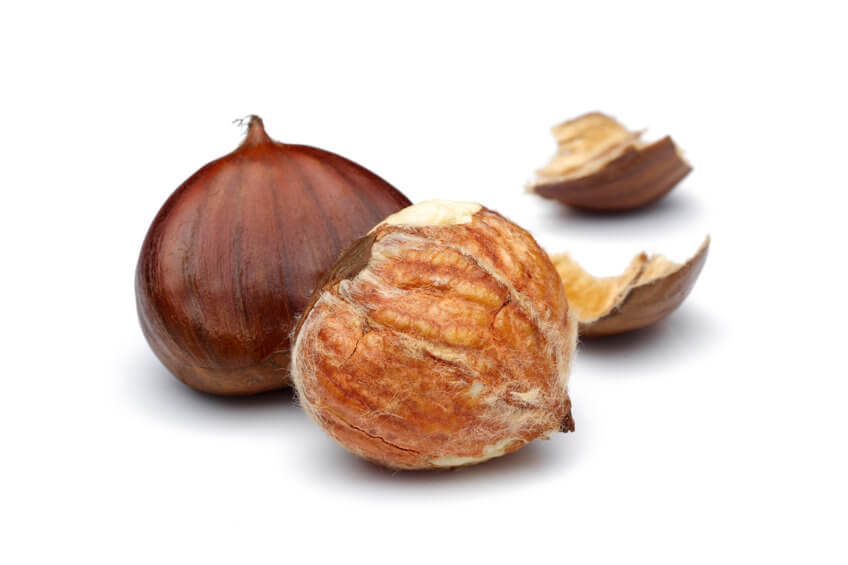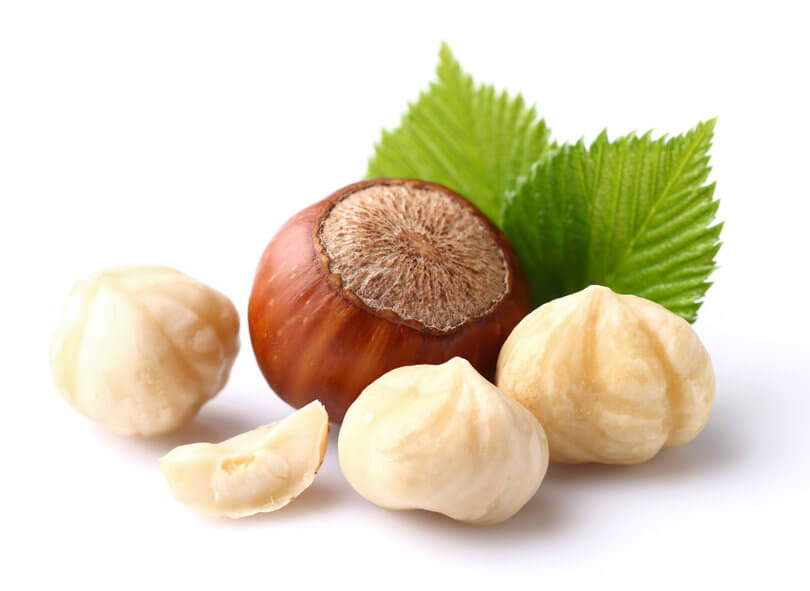Of all the different types of nuts nature has to offer, chestnuts and hazelnuts are two lesser-known varieties that may not always be as commercially available as other types. Both have much to offer in terms of taste and nutrition, but in this article we’ll be comparing chestnuts vs hazelnuts so we can see the pros and cons associated with each.
In short, the main difference between chestnuts vs hazelnuts is that chestnuts have less calories, are lower in fat, and contain more vitamin C and potassium. Hazelnuts, on the other hand, have less carbs and more protein, vitamins and minerals.
Let’s break down these details further.
What Are Chestnuts?
Chestnuts are a type of tree nut that grows in the temperate regions of the northern hemisphere.

They have a smooth, shiny exterior and their inner flesh is white or cream-colored, and they are typically only available on a seasonal basis.
One difference between chestnuts vs hazelnuts is that chestnuts should not be eaten raw. This is due to the tannic acid content, which can lead to illness when consumed in excess.
Because of this, chestnuts are usually cooked — either by roasting or boiling — long before they reach store shelves. You can break their hard exterior with a nut cracker or you can purchase them shelled.
According to WebMD, chestnuts can:
- Support heart health
- Improve digestion
What Are Hazelnuts?
Hazelnuts are small, round nuts that grow on trees in the Corylus genus.

Also known as filberts or cobnuts, these tasty nuts are encased in a hard shell that must be cracked open before eating.
Unlike chestnuts, hazelnuts can be eaten raw, roasted, or ground into a powder form.
Hazelnuts, much like chestnuts, have health-promoting benefits. According to WebMD, they can:
- Improve heart health
- Reduce cancer risk
Chestnuts VS Hazelnuts
While chestnuts and hazelnuts may share some similarities, there are also several key differences between these two types of nuts. Let’s explore these differences in greater detail.
Taste & Texture
One area where chestnuts and hazelnuts differ is their taste and texture.
Chestnuts, when cooked, have more of a sweet taste with a meaty texture that is unlike any other type of nut.
Hazelnuts, on the other hand, have an earthy flavor with a slightly musty texture. When eaten raw, however, they can have more of a bitter taste.
Nutrition Facts
Let’s have a look at how these two nuts compare in terms of nutritional contents.
The table below compares the nutrition facts of a 100-gram serving of roasted chestnuts with a similar serving size of hazelnuts:
| Item | Chestnuts | Hazelnuts |
| Serving Size | 100g | 100g |
| Calories | 245 | 628 |
| Total Carbohydrates | 53g | 16.7g |
| Fiber | 5.1g | 9.7g |
| Total Fat | 2.2g | 60.7g |
| Protein | 3.2g | 15g |
| Vitamin C | 43% DV | 11% DV |
| Vitamin E | 2% DV | 75% DV |
| Vitamin K | 10% DV | 18% DV |
| Calcium | 3% DV | 11% DV |
| Iron | 5% DV | 26% DV |
| Magnesium | 8% DV | 41% DV |
| Potassium | 17% DV | 19% DV |
| Zinc | 4% DV | 16% DV |
| Copper | 25% DV | 86% DV |
| Selenium | 2% DV | 3% DV |
As evident in the nutrition facts, these two nuts have a world of difference between them. Let’s explore.
Chestnuts Have Less Calories Per Serving
Calories are the unit of measurement used to gauge energy intake and expenditure. They can be a useful tool in managing ones weight, according to Mayo Clinic.
The most obvious difference between chestnuts vs hazelnuts is that hazelnuts contain roughly 2.5 as many calories per weight.
This means that you can eat a greater volume of food for less calories by opting for chestnuts.
Chestnuts Contain More Vitamin C
One of the more surprising revelations in our nut comparison is that chestnuts and hazelnuts are both sources of vitamin C. This is a rare trait among nuts.
Vitamin C is a water-soluble vitamin and antioxidant that can help protect cells from free radical damage. It also plays a role in wound healing and immune health, according to the National Institutes of Health.
If vitamin C is of importance to you then chestnuts would be the wiser choice, as they contain a whopping 43% of the Daily Value for just a single 100-gram serving. Hazelnuts, by comparison, only contain 11%.
Chestnuts Contain More Potassium Per Calorie
Not only do chestnuts have more vitamin C than hazelnuts, but they also contain more potassium per calorie.
In other words, although hazelnuts contain more potassium per weighted serving, chestnuts actually have more when adjusted for calories.
Potassium is an essential mineral and electrolyte that plays a role in managing fluid balance in the body. Its consumption is associated with lower blood pressure, according to Harvard Health Publishing.
Chestnuts Are Lower In Fat
Another benefit you’ll enjoy when opting for chestnuts vs hazelnuts is that the former contains significantly less fat. So if you’re seeking to limit your fat intake, chestnuts would be more advantageous.
Hazelnuts Have Less Carbs
Those seeking to limit their intake of carbohydrates would be better served opting for hazelnuts, as they contain only a third of the carbohydrates of chestnuts per serving– and that’s despite having more than twice as many calories!
This is particularly useful for anyone following a ketogenic (or “keto”) diet– a diet characterized by displacing carbohydrate calories with fat and protein. Hazelnuts are the clear winner here as they are more keto-friendly.
Hazelnuts Pack More Protein
Nuts and nut butters are traditionally seen as great sources of plant-based protein.
Protein is an essential macronutrient made up of amino acids. Protein is responsible for building and repairing tissue. It serves many other functions as well.
If protein is a priority for you then hazelnuts are the way to go as they provide nearly five-times as much protein per 100-gram serving as chestnuts do.
Hazelnuts Contain More Vitamins & Minerals
Finally, hazelnuts come packed with more vitamins and minerals than chestnuts do. Excluding vitamin C and potassium, hazelnuts pack more:
- Vitamin E, a fat-soluble vitamin that acts as an antioxidant
- Calcium, a mineral essential for bone health
- Iron, a mineral needed for transporting oxygen
- Magnesium, a mineral involved in over 300 biochemical reactions in the body
- Zinc, a mineral involved in immune function
- Copper, a mineral needed for making blood vessels
- And selenium, a trace mineral that plays a role in metabolism
The Bottom Line
The choice between chestnuts vs hazelnuts may very well come down to personal need. Although the nutritional benefits of each are plentiful, they do have stark differences between them.
Chestnuts have the advantage of having less calories, but hazelnuts have less carbs and more protein. Additionally, chestnuts require cooking, whereas hazelnuts can be eaten raw if desired.

